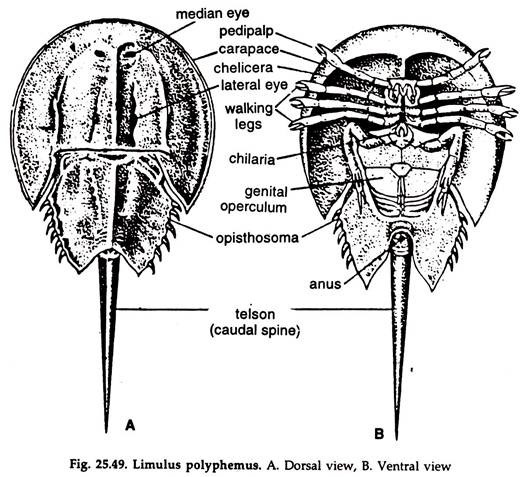In this article we will discuss about:- 1. Description of Limulus 2. Historical Background of Limulus 3. Systematic Account of Limulus 4. Distribution of Limulus 5. Ecology of Limulus 6. Anatomical Peculiarities of Limulus 7. Affinities of Limulus.
Contents:
- Description of Limulus
- Historical Background of Limulus
- Systematic Account of Limulus
- Distribution of Limulus
- Ecology of Limulus
- Anatomical Peculiarities of Limulus
- Affinities of Limulus
1. Description of Limulus:
The horse-shoe crabs—misnomerly called king crabs—are marine arthropods, which were abundant in Ordovician and Silurian periods. They have undergone little changes from the Silurian time and are represented by only five species today.
ADVERTISEMENTS:
This has earned the name “living fossils” for them. Extensive studies on these archaic creatures provide a good opportunity to know about a very primitive grade of arthropod organization.
2. Historical Background of Limulus:
Straus and Surekhein (1821) were first to study the horse-shoe crabs and considered them as arachnids. Later, Lankester (1881) recorded the presence of book-gills and strengthened their arachnid affinity. Tiegs and Manton (1958) placed them under the class Merostomata and subclass Xiphosauria along with subclass Eurypterida.
3. Systematic Account of Limulus:
The five existing species of horse-shoe crabs are placed in three genera—Limulus, Tachypleus and Carcinoscorpias. The largest measuring 60 cm including the telson is Limulus polyphemus.
4. Distribution of Limulus:
Limulus first appeared about 200 million years ago, in the Triassic Period. A number of fossils have been discovered from the Jurassic rocks. Today Limulus is restricted to the North-Western Atlantic coast of North America, while the other two genera are found along the coast of Asia (Japan, India, Korea and East Indies).
5. Ecology of Limulus:
ADVERTISEMENTS:
Horse-shoe crabs are inhabitants of shallow seas but some members occasionally occur in fresh water, as well as brackish estuarine waters. They burrow and forage for molluscs and worms in sand and mud with a head-on shoveling action of the carapace. The sixth pair of appendages push behind dug-out mud and sand.
In breeding season members of both the sexes come ashore and dig out holes at the upper limit of high tide for laying eggs. Adult individuals move by crawling while the young ones swim with help of their abdominal appendages.
6. Anatomical Peculiarities of Limulus:
1. Body divisible into prosoma, opisthosoma and metasoma (telson).
2. Prosoma covered dorsally with a broad horseshoe-shaped carapace (Fig. 25.49).
3. A median longitudinal ridge and two lateral grooves; two median eyes and two lateral eyes are present on the carapace.
4. Opisthosoma with serrated border; movable spines are six pairs.
5. Carapace and opisthosoma joined by a transverse hinge.
6. Postoral caudal spine (telson) hinged and movable.
7. Six pairs of cephalothoracic appendages—chelicerae, pedipalpi and four pairs of walking legs.
8. Mesosoma bears six pairs of flattened appendages. The first pair are without gills and united at the middle to form genital operculum. The rest five pairs are free and each carries a gill-book.
9. Muscles well-developed and attached to the abdomen and sternites.
10. Digestive tube bent, differentiated into zones; the anus ventral, at the base of the telson.
11. Heart tubular, long and with eight pairs of Ostia.
ADVERTISEMENTS:
12. Nervous system centralised and divisible into brain and a ganglionated, ventral nerve cord.
7. Affinities of Limulus:
Limulus has certain features common with several groups of both extinct and living non-chordates but quite a number of differences have also been recorded.
Affinities with Extinct Forms with Trilobite:
Similarities:
1. Cephalothorax with lateral eyes.
2. Appendages biramous.
3. Presence of lateral pleural spines.
4. Presence of trilobite stage in the life history of Limulus.
5. Certain fossils — Synxiphosura are very close to trilobites.
In spite of above similarities, Limulus differs from trilobites in having a telson, in the structure of genital operculum, abdominal appendages, and in the absence of antennae. Cephalothorax of trilobites is distinctly flattened.
With Eurypterida (fossil Merostomata):
Similarities:
1. Three similar body segments—prosoma, mesosoma and metasoma.
2. Similar cephalothoracic appendages and telson.
3. Structures of median and lateral eyes similar.
Although Limulus bears above mentioned similarities with Eurypterida, the dissimilarities are no less striking and rule cut the possibility of any close relationship. In fact, the Eurypterida exhibit a much closer relation with the modern Chelicerata (scorpions).
With Hemiaspidae (fossil Crustacea):
1. Construction of carapace and telson similar.
2. Lateral compound eyes present in both.
3. Trilobite larva of Limulus resembles some Hemiaspidae after first moult. Many workers believe that the affinities are merely superficial.
Affinities with living forms:
With crustacean:
Similarities:
1. Aquatic habits and similarity in appearance.
2. Appendages (specially abdominal) biramous.
3. Simple median and less complicated lateral eyes.
4. Presence of endosternite.
Dissimilarities:
1. Book-gills have no parallel structure in Crustacea.
2. Antennae absent in Limulus.
3. Absence of Nauplius larval stage in Limulus.
With Arachnida:
Similarities
1. Presence of a broad carapace.
2. Number and arrangement of cephalothoracic appendages.
3. Caudal spine of Limulus resembles the post-abdominal part of scorpion.
4. Structure of genital operculum.
5. Presence of median eyes.
6. Presence of endostennite.
7. Pharynx suctorial and symmetrical digestive glands.
8. Presence of coxal glands.
Dissimilarities:
1. Respiratory structures—book-gills and book-lungs are different.
2. Malpighian tubules absent in Limulus.
Attempts have been made to establish affinities of this archaic creature with other forms including chordates. Gaskell (1908) tried to establish its affinities with ammocoete larva of Petromyzon, largely based on the structure of dermal skeleton, median and lateral eyes, gills and endosternum.
But these similarities are only superficial. Patten (1912) attempted to establish affinity with ostracoderms (fossil armoured agnathans), but this gained a little support.
It appears that Limulus has much closer relationship with Arachnid and extinct Eurypterida than to any other arthropods. Formerly it was placed under the class Arachnida but Manton (1970) and others have assigned a separate class Merostomata for it along with eurypterids, and hold that Arthropoda is polyphyletic.
